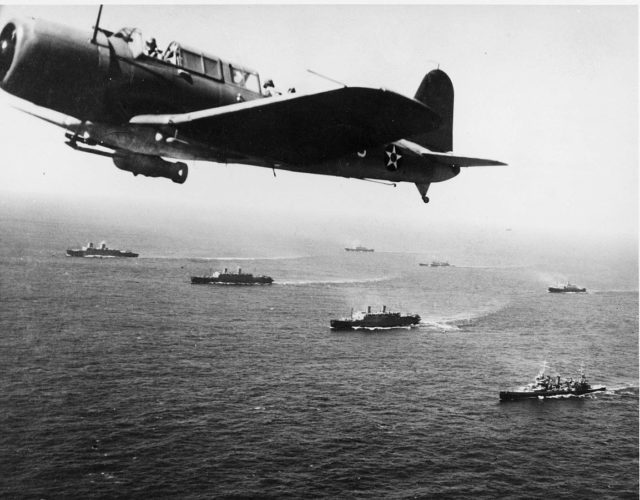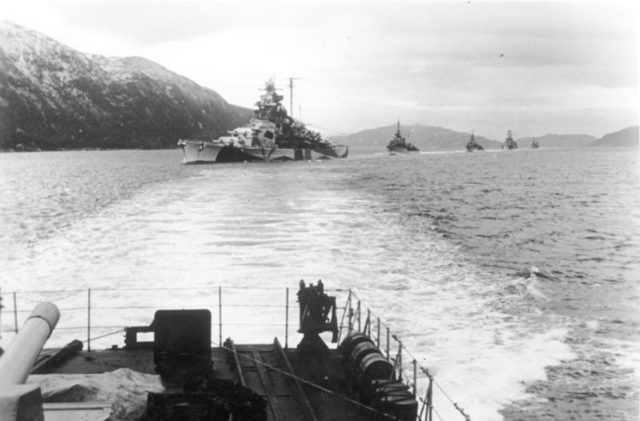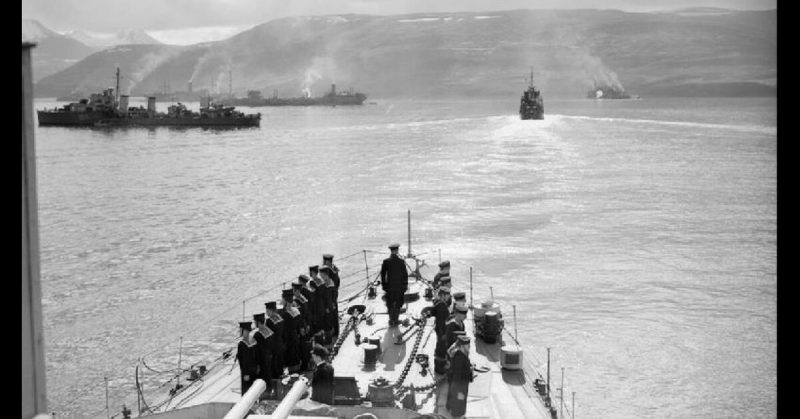Naval intelligence and the convoy system were vital to Britain’s survival during WWII. When used together, they saved countless lives and kept supplies flowing between the Allied powers. However, mistakes were made, and one of them brought disaster for the men of Convoy PQ 17.
The Convoy System
From early in WWII, the problem of moving supplies by sea loomed large for the British. Their economy was built on imports. Raw materials from all over the Empire fuelled British industry. Much of the food consumed came from abroad. Even before America entered the war, imports of American war materials were vital to the fight. After Russia’s entry, the Allies also sent goods to the Soviets.
German U-boats were a huge threat. Prowling the waters of the North Sea and Atlantic ocean, they sank merchant ships traveling to and from Britain.
The Royal Navy found that trying to hunt down submarines was difficult and often futile given the vast spaces involved. Instead, defense became the best form of attack. By grouping transport ships together into large convoys, the British protected them with military ships. When U-boats attacked, those forces had a chance to destroy them.

PQ 17
PQ 17 was one of those convoys. On June 27, 1942, it set sail from Iceland toward Russia. Its cargo included 210 aircraft, packed away in crates for the journey, and 430 tanks. Its military escort consisted of:
- Four cruisers
- Nine destroyers
- Two anti-aircraft ships
- Four Corvettes
- Two submarines
- Three minesweepers
- Four ocean escort trawlers
The British Home Fleet also provided cover from a distance. At its disposal were:
- Two battleships
- Two cruisers
- A fleet carrier
- Fourteen destroyers
The convoy’s route was a balancing act. Too far south, it would be vulnerable to German bombers flying out of occupied Norway. Too far north and it would hit the Arctic ice flows.
Naval Intelligence
From the start of the war, the British Navy provided the best military intelligence service in the country, possibly in the world. There was little military intelligence planning between the wars, but the Royal Navy had started ahead of its peers. Its submarine tracking room, which did much to help the convoys avoid U-boats, was one of the most remarkable analytical operations of the war.
As PQ 17 set out, there were three sources of intelligence on German activity where it was sailing:
- The interception of low-level messages between naval units in German home waters. They used a code known as Dolphin, which the British could decrypt.
- Agents in Norway.
- Interception of high-level signals between German commanders, encoded using Enigma machines. Polish and British operatives had cracked that cipher and could decrypt the messages. In Britain, it was known as Ultra.

Unfortunately for PQ 17, two of those sources were less effective that summer. Technicalities caused delays in Dolphin decryptions, leaving the Allies without that intelligence for stretches of up to two days at a time. There were no operatives in the right part of Norway with access to relevant information for the convoy.
Everything relied on Ultra.
Pound and the Tirpitz
The Allies were afraid of the German ship Tirpitz attacking the convoy. She was one of the most powerful battleships ever built. They knew it was in Altafjord, within striking distance of the convoy’s route.
The British hunt for the Tirpitz had two effects. One was that, unknown to them, Hitler had ordered the ship to stay safely in port. The other was that British commanders were over-sensitive to its presence. If it got in among a convoy it could wreak terrible havoc, a vision no admiral seemed able to shake.
It was on the mind of Dudley Pound, the First Sea Lord when he visited the Operational Intelligence Centre on July 3. Pound had barely touched military intelligence up to then, and it was PQ 17’s misfortune that he chose that day to do so.
The Call to Scatter
Pound asked where the Tirpitz was. Hearing that it was within striking distance of PQ 17’s route, he began to worry. A break in Ultra intelligence then left him and the rest of the officers blind to the battleship’s activities. Pound worried the Tirpitz might emerge and attack the convoy. He thought the convoy should scatter for the sake of safety.
Lieutenant-Commander Norman Denning, the head of OIC, tried to talk him out of it, as did Admiral Sir John Tovey, an experienced commander of anti-submarine operations. They were experts in their fields, but Pound outranked them both.
Late on the night of July 4, on Pound’s orders, support forces were withdrawn and the convoy scattered.
Outcome
The result was disastrous. The Tirpitz emerged the next day to attack the isolated ships of the convoy but returned to the Fjord as it was not needed. U-boats and aircraft picked off the unprotected ships. Two-thirds of Convoy PQ 17 were lost; ships, men, and cargo vanishing into icy oblivion. Hundreds of miles away from the man who had made the fatal decision, bombs and torpedoes brought terrifying death upon brave merchant seamen.
It will never be known for certain what would have happened if the convoy had stayed together. It was immediately evident that it was doomed while scattered. Because a senior commander had not been willing to listen to skilled experts of lower rank, lives had been needlessly lost.
Source:
Ralph Bennett (1999), Behind the Battle: Intelligence in the War with Germany 1939-1945;
